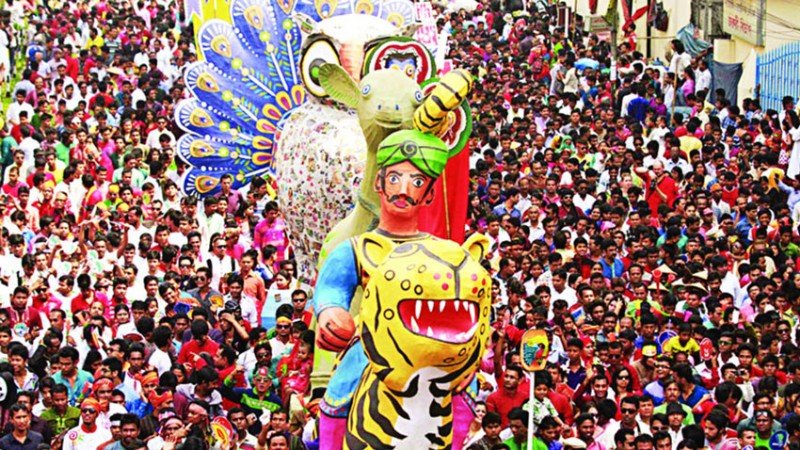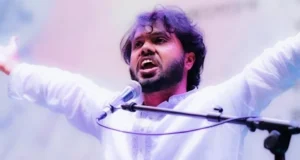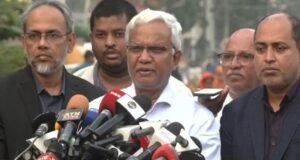
Bangladesh is set to celebrate Pahela Baishakh, the first day of Bangla New Year 1432, on Monday with widespread festivities that emphasize inclusivity by engaging communities from all ethnic backgrounds.
Large crowds are expected to join “Nobo Barsho” celebrations throughout the country, especially in Dhaka, where vibrant events and processions will take place. As one of the most colorful and culturally significant festivals in the country, Pahela Baishakh marks the end of the old year and the beginning of a new one with joy, unity, and tradition.
People from all walks of life participate in the celebrations, wearing traditional attire. Bangalee women typically wear white sarees with red borders, adorned with bangles, flowers, and decorative forehead tips, while men dress in white pyjamas and panjabis. Members of ethnic communities also wear their respective cultural garments.
For the first time, the government has arranged a two-day programme to celebrate both Chaitra Sankranti and Pahela Baishakh in a more inclusive manner, aiming to represent all ethnic groups. The Ministry of Cultural Affairs announced that the Bangla New Year 1432 and the new years of indigenous communities such as the Chakma, Marma, Tripura, and Garo will be celebrated together on a national level.
Various government ministries, divisions, educational institutions, district and upazila administrations, municipal bodies, and cultural organizations are involved in implementing the events. Chief Adviser Professor Muhammad Yunus has extended his greetings to the nation on the occasion.
This year, newspapers will publish special features to highlight the significance of the Bangla New Year instead of traditional supplements. Bangladesh Television, Bangladesh Betar, and other media outlets will broadcast dedicated reports. The Ministry of Information and Broadcasting will ensure full media coverage.
The celebrations will officially begin on Pahela Baishakh morning with the singing of the national anthem and the traditional welcoming song “Esho He Boishakh, Esho Esho.” At 9 am, the Faculty of Fine Arts of Dhaka University will host the grand “Barshobaran Ananda Shobhajatra” procession, followed by cultural performances.
This year’s procession is designed to be more inclusive than ever before, welcoming participation from ethnic minority groups including the Chakma, Marma, Tripura, Garo, Manipuri, and others. Female footballers will also take part in the festivities. Each group will present its own cultural identity through music and traditional instruments. The Bangladesh Shilpakala Academy will coordinate participation from the three hill districts and other indigenous communities.
The Ministry of Information and Broadcasting has ensured that the processions will be broadcast live on all government and private television channels, as well as on radio and community stations.
Numerous cultural organizations, including Shurer Dhara, Rishij Shilpigoshthi, Bulbul Lalitakala Academy, and Garo cultural groups, will stage performances. The Department of Theatre and Performance Studies of Dhaka University and other renowned groups will also take part. Leading cultural institution Chhayanaut will organize a special dawn event at Ramna Batamul to welcome the new year.
Processions and cultural events will be held across every district, upazila, and union, involving people from all communities. Local administrations will organize traditional fairs, cultural shows, essay contests, and various competitions to engage the public.
All educational institutions will independently celebrate the day with festive programs. Bangla Academy and the Bangladesh Small and Cottage Industries Corporation will hold a weeklong Baishakhi fair and discussion sessions. The Bangladesh Folk Art and Crafts Foundation will also organize a New Year fair in the capital.
Traditional Bangla foods will be served in all prisons, hospitals, and children’s homes, with special cultural activities arranged for children in orphanages. Exhibitions of prisoner-made crafts will also be showcased. Bangladesh’s diplomatic missions abroad will mark the occasion with their own events.
Museums and archaeological sites across the country will be open to the public, and entry will be free for students, children, adolescents, and those with disabilities. A special exhibition focusing on the history and heritage of the Bangla New Year will be organized.
Hotels and clubs will serve traditional dishes and host events in celebration of the day. Offices under the Ministry of Cultural Affairs will arrange discussions, exhibitions, and various competitions to further promote the celebration. Ethnic minority cultural institutions will host independent programmes reflecting their own traditions.
In the evening, the Bangladesh Shilpakala Academy will host a vibrant drone show and cultural event at the South Plaza of the Jatiya Sangsad with support from the Ministry of Cultural Affairs. A concert marking Chaitra Sankranti will be held at Suhrawardy Udyan, while roaming music performances, an art exhibition, and a traditional stick-fighting display known as “Lathi Khela” will also be part of the festivities.
Security has been reinforced across all administrative levels to ensure safe and peaceful celebrations. Law enforcement agencies will maintain public order while facilitating free access to event venues. The Fire Service and Civil Defence will be on standby for emergencies.
Local fairs will feature regional folk culture, with measures in place to prevent gambling and inappropriate activities. Medical service centers have been set up near Suhrawardy Udyan and Ramna Park, while Dhaka WASA has ensured a steady supply of fresh water. Mobile toilets have also been installed in these areas for public convenience.
Efforts are underway to promote Pahela Baishakh as a symbol of cultural heritage through social media and religious institutions. Historians credit Mughal Emperor Akbar with initiating the Bangla calendar, originally created to align tax collection with the solar agricultural calendar. His royal astronomer Fathullah Shirazi combined elements of the lunar Islamic and solar Hindu calendars to establish what became known as the Fasholi Shan, or harvest calendar.
 Weekly Bangla Mirror | Bangla Mirror, Bangladeshi news in UK, bangla mirror news
Weekly Bangla Mirror | Bangla Mirror, Bangladeshi news in UK, bangla mirror news







